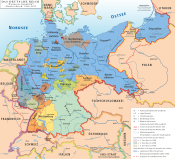Free State of Schaumburg-Lippe
| Free State of Schaumburg-Lippe Freistaat Schaumburg-Lippe | |||||||||
|---|---|---|---|---|---|---|---|---|---|
| State of Germany | |||||||||
| 1918–1946 | |||||||||
 Flag
 Coat of arms
| |||||||||
 The Free State of Schaumburg-Lippe (red) within the Weimar Republic | |||||||||
| Capital | Bückeburg | ||||||||
| Area | |||||||||
• 1939 | 340 km2 (130 sq mi) | ||||||||
| Population | |||||||||
• 1939 | 53277 | ||||||||
| Government | |||||||||
| • Type | Republic | ||||||||
| Minister-President | |||||||||
• 1918 (first) | Friedrich von Feilitzsch | ||||||||
• 1933–1945 | Karl Dreiera | ||||||||
• 1945–1946 (last) | Heinrich Hermann Drakeb | ||||||||
| Reichsstatthalter | |||||||||
• 1933–1945 | Alfred Meyer | ||||||||
| Historical era | Interwar · World War II | ||||||||
| 15 November 1918 | |||||||||
• Disestablished | 1 November 1946 | ||||||||
| |||||||||
| a. As State President. b. As "Minister". | |||||||||
The Free State of Schaumburg-Lippe (German: Freistaat Schaumburg-Lippe) was created following the abdication of Prince Adolf II of Schaumburg-Lippe on 15 November 1918. It was a state in Germany during the Weimar Republic, headed by a Minister President. The democratic government was suppressed during Nazi rule. At the end of World War II the British military occupation government decreed on 1 November 1946 the union of Schaumburg-Lippe, Hannover, Braunschweig, and Oldenburg to form the new state of Lower Saxony.
Leaders[]
Minister of State[]
- Friedrich Freiherr von Feilitzsch (15 November 1918 – 3 December 1918)
Chairman of the State Council[]
- Heinrich Lorenz (SPD, 4 December 1918 – 14 March 1919)
State Councillors[]
- Otto Bönners (14 March 1919 – 22 May 1922)
- Konrad Wippermann (22 May 1922 – 28 May 1925)
- Erich Steinbrecher (SPD, 28 May 1925 – 7 October 1927)
- Heinrich Lorenz (SPD, 7 October 1927 – 7 March 1933)
- Hans-Joachim Riecke (NSDAP, 1 April – 23 May 1933)
State Presidents[]
- Alfred Meyer (NSDAP, as Reichsstatthalter; 16 May 1933 – 4 April 1945)
- Karl Dreier (NSDAP, 25 May 1933 – March 1945)
Minister[]
- Heinrich Hermann Drake (SPD, 1945 – 30 April 1946)

Map showing Lippe and Schaumburg-Lippe
External links[]
Categories:
- States and territories established in 1918
- States and territories disestablished in 1946
- States of the Weimar Republic
- 1918 establishments in Germany
- German history stubs
